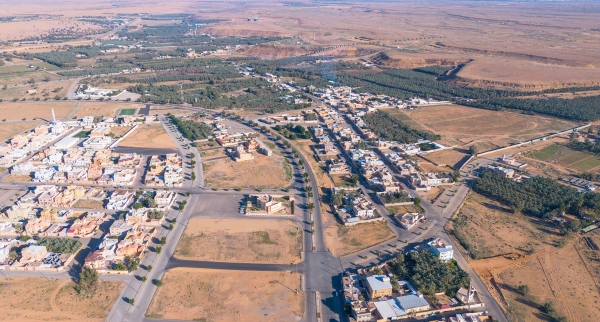

Ar-Rubay'iyyah Historical Village is a historical, archaeological, and agricultural region located east of Buraydah City in Qassim Province, central Kingdom of Saudi Arabia. It is situated approximately twenty-eight km from Buraydah City. According to administrative divisions, ar-Rubay'iyyah is classified as a Category ‘A’ center, connected to Buraydah City, which serves as the administrative capital of Qassim Province.
Ar-Rubay'iyyah Historical Village history
Ar-Rubay'iyyah Location was known during the early Islamic centuries as al-Diratain or Rawdat al-Zubratain. Yaqut al-Hamawi described al-Diratain as "two meadows belonging to Bani Asid at the confluence of Wadi al-Rummah from al-Taneem (Qassim) on the left side of the pilgrim's ascending road." The village's urban development began in the eighteenth century.
The passage of Wadi al-Rummah through the lands of ar-Rubay'iyyah Village granted the area historical and present significance, as it served as a passage for pilgrims, traders, and travelers along the Iraqi-Basra Hajj route, which included al-Sarif, al-Buraykah, and Qa'a Bawlan. In modern times, ar-Rubay'iyyah has become a station on the Riyadh-al-Washm-Qassim and Riyadh-Sudayr-Qassim roads.
Landmarks in ar-Rubay'iyyah Historical Village
Ar-Rubay'iyyah features several stone circles in various locations to the east and northeast of the village, spanning from al-Asyah Road in the north to King Abdulaziz Road in the south. The distance between each of these structures ranges from half a km to a km. Most of these installations are situated along the various rocky edges in this area.
Other landmarks include al-Buraykah, and al-Sarif, which witnessed the Battle of al-Sarif. There's also Qa'a Bawlan, a vast and flat area located southwest of ar-Rubay'iyyah, historically known and mentioned by some early poets. This plain was traversed by pilgrims and travelers who came via the Basra Hajj route. Additionally, there's 'al-Abriyah' tree, estimated to be over 250 years old, famous as a resting spot for travelers passing through ar-Rubay'iyyah.
East of ar-Rubay'iyyah, on the rocky ridge, are two towers used historically for enemy surveillance and defense before they could surprise the village. One tower overlooks the village center and the old Emirate Palace. It was restored by residents in 1985. The other tower overlooks the northern part of the town and still retains its shape despite some parts collapsing.
In 1929, the founding King Abdulaziz Bin Abdulrahman Al Saud traveled to Qassim and passed through ar-Rubay'iyyah on his first journey to the area by car. Due to the difficult terrain in the eastern part of ar-Rubay'iyyah, the Governor of ar-Rubay'iyyah and its residents repaired the road to allow the king's convoy to pass. This road became known as King Abdulaziz Road, and part of it was later paved and asphalted.
The old Emirate Palace is one of the prominent and oldest historical palaces in ar-Rubay'iyyah; it was established around 1834. The palace is square-shaped, surrounded by a large wall, with a watchtower at each corner. The northeastern tower and parts of the southeastern tower remain, along with sections of the palace walls, rooms, and water wells. The remaining structure confirms its strength, durability, and quality of design. This palace is also one of the sites where the residents of ar-Rubay'iyyah were besieged when Bandar Bin Rashid attacked them in the 1880s.
It is said that there are remnants of wells and buried structures under the sands of Arq al-Uwayqir, south of ar-Rikiyah, on the right side of the road leading towards an-Nabqiyah via al-Asyah road. Additionally, there are remnants of agriculture buried by sands in ar-Rikiyah, north of ar-Rubay'iyyah, about 9.8 km away, specifically in Rawdat Sha'jaan in the central part of northwest ar-Rikiyah. Historians have noted the presence of agricultural remnants, as well as the remains of a well buried by sands, which, when re-dug, was found to be lined with stones. At its bottom, they discovered some human skulls buried there. It is also mentioned that there are other remains in the western part of ar-Rikiyah, buried in the sands. These remnants include walls, buildings, palaces, towers, and old wells in ar-Rubay'iyyah.
Significant historical events in ar-Rubay'iyyah historical village
Among the notable historical events that took place in ar-Rubay'iyyah (and nearby), Imam Abdullah Bin Faisal Bin Turki used it as his base in 1854-1855 and again in 1861 during his expeditions to Qassim. Its strategic location made it a starting point for several of his military operations. Additionally, ar-Rubay'iyyah endured a siege lasting over a month by Bandar Bin Rashid, during which the residents successfully defended the village.
Ar-Rubay'iyyah historical village witnessed the Battle of al-Sarif in 1901, between the son of the Prince of Kuwait, along with the people of Qassim, against Ibn Rashid. The battle began with Ibn Rashid's army attacking the people of Qassim with Ibn Sabah at Quweira al-Hakim, north of al-Tarfiyah, 3.2 km away, then extended to al-Sarif. Additionally, the village witnessed the Battle of Abraq al-Madhbah, known as Rawdat Muhanna, in 1906, one of the significant battles fought by the founding King Abdulaziz Bin Abdulrahman Al Saud.
Related quizzes
Related articles
